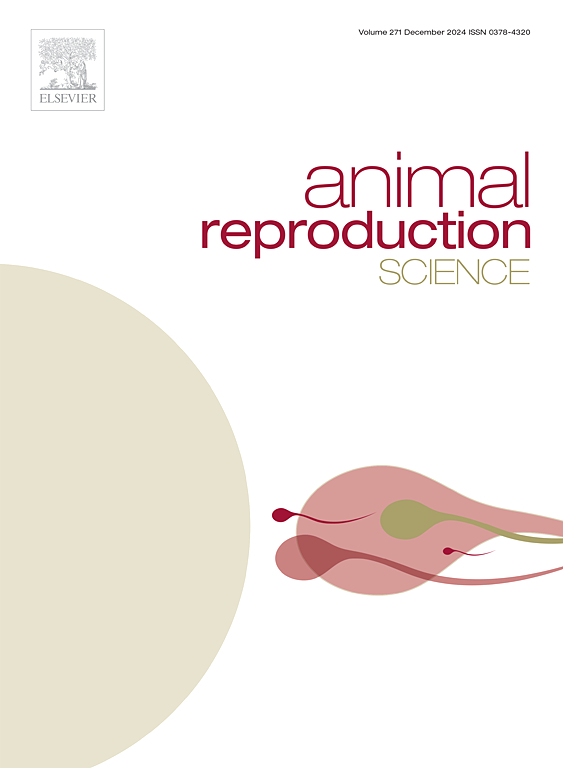大口鲈鱼(Micropterus salmoides)胚胎玻璃化冷冻保存的最佳条件
IF 2.2
2区 农林科学
Q1 AGRICULTURE, DAIRY & ANIMAL SCIENCE
引用次数: 0
摘要
大口鲈鱼(Micropterus salmoides)是世界上重要的淡水养殖品种之一。然而,由于引种规模限制、高密度养殖、近亲繁殖、物种杂交等原因,大口鲈种质资源面临退化、易感染疾病等威胁。因此,开展其原始优良种质资源的保存研究迫在眉睫。我们优化了大口鲈胚胎玻璃化和复苏的冷冻保存条件,包括冷冻保护剂的混合比例、胚胎阶段、平衡步骤和温度以及洗涤调节剂。结果表明,毒性最小的单一、二元和三元混合渗透性冷冻保护剂分别是 PG、PM(PG:MeOH = 2:1)和 PMD(PM:DMSO = 3:1)。毒性最小的非渗透性冷冻保护剂是 5%的葡萄糖。选择的最佳玻璃化溶液是 PMDG(30 % PMD + 5 % 葡萄糖),胚胎存活率为 80.67%。处于心跳阶段的胚胎对 PMDG 溶液有很强的耐受性,这是冷冻保存胚胎的最佳阶段。在平衡过程中,五步平衡法或将冷冻保护剂预冷至 4°C 都可降低其毒性。在清洗过程中,使用 0.125 mol-L-1 的蔗糖溶液效果最佳。根据优化的条件,对 650 个处于心跳阶段的胚胎进行了玻璃化冷冻保存,共获得 350 个完整透明的卵,其中两个成功孵化。这些结果为进一步提高大口鲈和其他鱼类的玻璃化冷冻保存效率提供了参考。本文章由计算机程序翻译,如有差异,请以英文原文为准。
Optimal conditions for cryopreservation by vitrification of largemouth bass (Micropterus salmoides) embryos
The largemouth bass (Micropterus salmoides) is one of the important freshwater aquaculture species in the world. However, due to limitations on introduction scale, high-density farming, inbreeding, and species hybridization, the germplasm resources of largemouth bass face threats such as degradation and susceptibility to diseases. Therefore, it is urgent to conduct research on the conservation of its original and good germplasm resources. We optimized the conditions of cryopreservation to vitrify and revive largemouth bass embryos, including the mixing ratio of cryoprotectants, embryo stage, equilibration step and temperature, and washing regent. The results showed that the least toxic single, binary, and ternary mixed permeating cryoprotectants were PG, PM (PG: MeOH = 2:1), and PMD (PM: DMSO = 3:1), respectively. The least toxic non-permeating cryoprotectant was 5 % glucose. The optimal vitrification solution selected was PMDG (30 % PMD + 5 % glucose) with an 80.67 % survival rate of embryos. Embryos at the heartbeat stage exhibited strong tolerance to the PMDG solution, which is the optimal embryo stage for cryopreservation. During the equilibration process, either the five-step equilibration method or pre-cooling the cryoprotectant to 4°C could reduce its toxicity. During the washing process, a 0.125 mol·L−1 sucrose solution yielded the best results. Based on the optimized conditions, 650 embryos at the heartbeat stage were subjected to cryopreservation by vitrification, resulting in a total of 350 intact transparent eggs, two of which hatched successfully. The results provide a reference for further improving the efficiency of cryopreservation by vitrification of largemouth bass and other fish species.
求助全文
通过发布文献求助,成功后即可免费获取论文全文。
去求助
来源期刊

Animal Reproduction Science
农林科学-奶制品与动物科学
CiteScore
4.50
自引率
9.10%
发文量
136
审稿时长
54 days
期刊介绍:
Animal Reproduction Science publishes results from studies relating to reproduction and fertility in animals. This includes both fundamental research and applied studies, including management practices that increase our understanding of the biology and manipulation of reproduction. Manuscripts should go into depth in the mechanisms involved in the research reported, rather than a give a mere description of findings. The focus is on animals that are useful to humans including food- and fibre-producing; companion/recreational; captive; and endangered species including zoo animals, but excluding laboratory animals unless the results of the study provide new information that impacts the basic understanding of the biology or manipulation of reproduction.
The journal''s scope includes the study of reproductive physiology and endocrinology, reproductive cycles, natural and artificial control of reproduction, preservation and use of gametes and embryos, pregnancy and parturition, infertility and sterility, diagnostic and therapeutic techniques.
The Editorial Board of Animal Reproduction Science has decided not to publish papers in which there is an exclusive examination of the in vitro development of oocytes and embryos; however, there will be consideration of papers that include in vitro studies where the source of the oocytes and/or development of the embryos beyond the blastocyst stage is part of the experimental design.
 求助内容:
求助内容: 应助结果提醒方式:
应助结果提醒方式:


